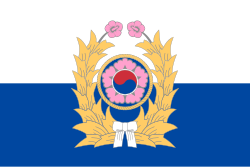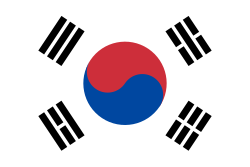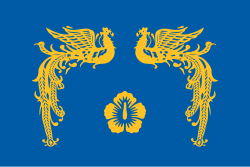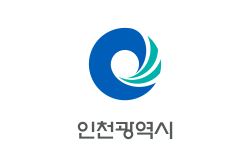| Flag | Date | Use | Description |
|---|
 | 1948–present |  Flag of the Armed Forces Flag of the Armed Forces | Insignia of the armed forces on a red field. |
 | ?–present |  Flag of the Minister of National Defense Flag of the Minister of National Defense | Insignia of the armed forces and four stars on a red field. |
 | ?–present |  Flag of the Vice Minister of National Defense Flag of the Vice Minister of National Defense | Insignia of the armed forces and four stars on a blue field. |
 | ?–present |  Flag of the Joint Chiefs of Staff Flag of the Joint Chiefs of Staff | Crimson flag with the insignia of the JCS and the words 합동참모본부. |
 | ?–present |  Flag of the Chairman of the Joint Chiefs of Staff Flag of the Chairman of the Joint Chiefs of Staff | Insignia of the Chairman of the Joint Chiefs of Staff on a crimson field. |
 | 1946–present |  Flag of the Army Flag of the Army | Insignia of the army on a field parted per fess; above is white, below is blue. |
 | ?–present |  Flag of the Chief of Staff of the Army Flag of the Chief of Staff of the Army | Insignia of the Chief of Staff and four stars on a red field. |
 | ?–present |  Flag of the Daejang Flag of the Daejang | Four stars and a Hibiscus syriacus on a red field. |
 | ?–present |  Flag of the Jungjang Flag of the Jungjang | Three stars and a Hibiscus syriacus on a red field. |
 | ?–present |  Flag of the Sojang Flag of the Sojang | Two stars and a Hibiscus syriacus on a red field. |
 | ?–present |  Flag of the Junjang Flag of the Junjang | A star and a Hibiscus syriacus on a red field. |
 | 1955–present | Naval ensign, navy flag, and naval jack | Taegeuk on crossed anchors in a white canton on a blue field |
 | ?–present |  Flag of the Chief of Naval Operations Flag of the Chief of Naval Operations | Insignia of the Chief of Naval Operations and four stars on a blue field |
 | ?–present |  Flag of the Daejang Flag of the Daejang | Four stars and a Hibiscus syriacus on a blue field. |
 | ?–present |  Flag of the Jungjang Flag of the Jungjang | Three stars and a Hibiscus syriacus on a blue field. |
 | ?–present |  Flag of the Sojang Flag of the Sojang | Two stars and a Hibiscus syriacus on a blue field. |
 | ?–present |  Flag of the Junjang Flag of the Junjang | A star and a Hibiscus syriacus on a blue field. |
 | 1952–present |  Flag of the Marine Corps Flag of the Marine Corps | The similarity with the flag of the United States Marine Corps shows the strong influence of the United States since the creation of South Korean armed forces. |
 | ?–present |  Flag of the Commandant of the Marine Corps Flag of the Commandant of the Marine Corps | Three stars above the insignia of the Marine Corps on a red field. |
 | ?–present |  Flag of the Jungjang Flag of the Jungjang | Three stars and a Hibiscus syriacus on a red field. |
 | ?–present |  Flag of the Sojang Flag of the Sojang | Two stars and a Hibiscus syriacus on a red field. |
 | ?–present |  Flag of the Junjang Flag of the Junjang | A star and a Hibiscus syriacus on a red field. |
 | 1952–present |  Flag of the Air Force Flag of the Air Force | Insignia of the air force on a sky blue field. |
 | ?–present |  Flag of the Chief of Staff of the Air Force Flag of the Chief of Staff of the Air Force | Insignia of the Chief of Staff and four stars on a sky blue field. |
 | ?–present |  Flag of the Daejang Flag of the Daejang | Four stars and a Hibiscus syriacus on a sky blue field. |
 | ?–present |  Flag of the Jungjang Flag of the Jungjang | Three stars and a Hibiscus syriacus on a sky blue field. |
 | ?–present |  Flag of the Sojang Flag of the Sojang | Two stars and a Hibiscus syriacus on a sky blue field. |
 | ?–present |  Flag of the Junjang Flag of the Junjang | A star and a Hibiscus syriacus on a sky blue field. |
 | 1968–present | Flag of the Republic of Korea Reserve Forces | Insignia of the Reserve Forces on a blue field. |




















































































































































































































